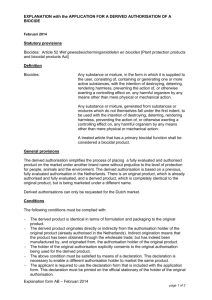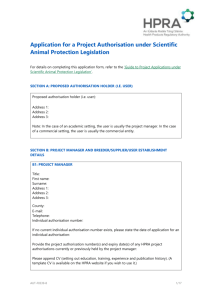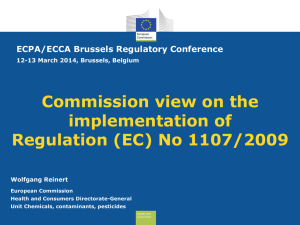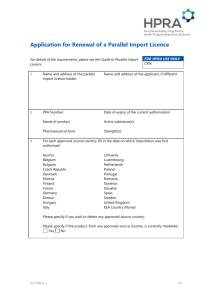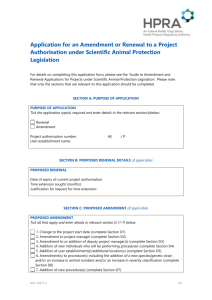project_authorisation_app
advertisement
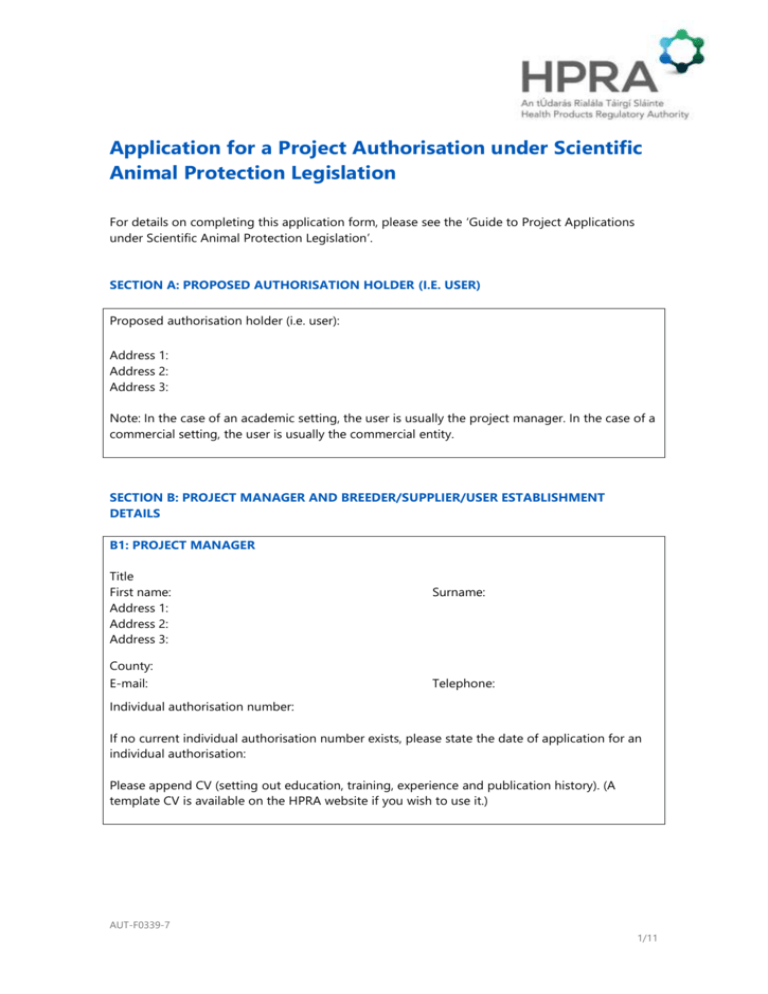
Application for a Project Authorisation under Scientific Animal Protection Legislation For details on completing this application form, please see the ‘Guide to Project Applications under Scientific Animal Protection Legislation’. SECTION A: PROPOSED AUTHORISATION HOLDER (I.E. USER) Proposed authorisation holder (i.e. user): Address 1: Address 2: Address 3: Note: In the case of an academic setting, the user is usually the project manager. In the case of a commercial setting, the user is usually the commercial entity. SECTION B: PROJECT MANAGER AND BREEDER/SUPPLIER/USER ESTABLISHMENT DETAILS B1: PROJECT MANAGER Title First name: Address 1: Address 2: Address 3: County: E-mail: Surname: Telephone: Individual authorisation number: If no current individual authorisation number exists, please state the date of application for an individual authorisation: Please append CV (setting out education, training, experience and publication history). (A template CV is available on the HPRA website if you wish to use it.) AUT-F0339-7 1/11 B2: DEPUTY PROJECT MANAGER DETAILS (if applicable) Title: First name: Address 1: Address 2: Address 3: County: E-mail: Individual authorisation number: Surname: Telephone: If no current individual authorisation number exists, please state the date of application for an individual authorisation: Please append CV (setting out education, training, experience and publication history). (A template CV is available on the HPRA website if you wish to use it.) B3: USER ESTABLISHMENT DETAILS USER ESTABLISHMENT NAME USER ESTABLISHMENT AUTHORISATION NUMBER Address where the project will be conducted: In the case of a collaboration, list the user establishment authorisation number of each user establishment at which the applicant will participate in project work: USER ESTABLISHMENT NAME USER ESTABLISHMENT AUTHORISATION NUMBER List any location other than the authorised user establishment(s) where procedures will be carried out and provide a scientific justification as to why each additional location is necessary. AUT-F0339-7 2/11 SECTION C: PROJECT INFORMATION Project title (≤ 500 characters): Is this project being performed solely to satisfy regulatory requirements? Is this project application solely for production or diagnostic purposes using recognised established methods? Has this project been approved by an ethics committee? Yes No Yes Yes No No If ‘yes’ please provide a copy of the ethical review application and associated approval documentation from the relevant ethics committee as outlined in the guide to projects. If ‘no’ please provide a justification as to why an ethical review was not performed: State expected duration of project work (months): State estimated start date of project work: State the total number of animals per species to be used for this project: SPECIES NUMBER OF ANIMALS Provide details of the individuals who will be performing procedures as part of this project: FIRST NAME SURNAME INDIVIDUAL If no current individual authorisation AUTHORISATION number is held, state the date of application NUMBER for an individual authorisation AUT-F0339-7 3/11 SECTION D: PROJECT PURPOSE D1: PROJECT DETAILS Describe the overall purpose of the project (≤ 5000 characters): Describe the current state of scientific knowledge for the work to be performed on this project (≤ 5000 characters): How do the objectives of this project differ from the findings of previous studies in this area (to include evidence of the literature research performed)? (≤ 5000 characters): Detail the expected scientific benefit of the project (≤ 5000 characters): Describe the feasibility and the resources available for the project (≤ 5000 characters): D2: PURPOSE OF THE PROJECT Provide information on the proposed purpose of this project, selecting from the list below. Please refer to the Guide to Projects Applications Regulated by Directive 2010/63/EU and S.I. No. 543 of 2012 for expanded project purposes if required. Note: a completed application form must be provided for each project proposed. Basic research - select sub-field(s) Translational and applied research - select sub-field(s) Regulatory use and routine production - select sub-field(s) Protection of the natural environment in the interests of the health or welfare of human beings or animals Preservation of species Higher education or training for the acquisition, maintenance or improvement of vocational skills Maintenance of colonies of established genetically altered animals, not used in other procedures Forensic inquiries SECTION E: NON-TECHNICAL PROJECT SUMMARY Provide a completed ‘Non-Technical Project Summary for a Project Regulated by Directive 2010/63/EU and S.I. No. 543 of 2012’ form available on the ‘Publications and Forms’ section of www.hpra.ie with each project application form. AUT-F0339-7 4/11 SECTION F: EXPERIMENTAL DESIGN Using the table below, provide information on each of the procedures to be carried out as part of this project in chronological order, detailing the technique involved, the severity classification and the methods of pain relief and humane endpoints in place. For each procedure, provide a justification as to why each procedure is required. The table can be expanded by copying and pasting sections as many times as required depending on the number of procedures to be conducted. Procedure number Species Life stage Technique Duration of procedure Frequency of procedure Pain-relieving methods and/or anaesthesia Proposed severity classification Humane endpoints Number of animals to be used Justification/relevance of procedure Adverse effect(s) of procedure on animal welfare What is the fate of the animals at the end of the procedure? If the fate of the animals is euthanasia, please state the method of euthanasia Procedure number Species Life stage Technique Duration of procedure Frequency of procedure Pain-relieving methods and/or anaesthesia Proposed severity classification Humane endpoints Number of animals to be used Justification/relevance of procedure Adverse effect(s) of procedure on animal welfare What is the fate of the animals at the end of the procedure? AUT-F0339-7 5/11 If the fate of the animals is euthanasia, please state the method of euthanasia Procedure number Species Life stage Technique Duration of procedure Frequency of procedure Pain-relieving methods and/or anaesthesia Proposed severity classification Humane endpoints Number of animals to be used Justification/relevance of procedure Adverse effect(s) of procedure on animal welfare What is the fate of the animals at the end of the procedure? If the fate of the animals is euthanasia, please state the method of euthanasia Please append the project protocol, giving specific details for each procedure and indicating the flow of procedures. The steps involved should be clearly numbered (from beginning to end) in schematic or illustrative form and should correspond with the table above. SECTION G: ANIMAL INFORMATION G1: APPLICATION OF METHODS TO REPLACE, REDUCE AND REFINE THE USE OF ANIMALS REPLACEMENT Provide the reasons why the objectives of this project are not achievable through the use of alternative methods to animal testing and indicate what sources you consulted to track possible alternatives (≤ 5000 characters): REDUCTION Provide justification on the number of animals to be used in this project, specifying the principles of experimental design used to calculate the sample group size (≤ 5000 characters): REFINEMENT Provide information relating to the choice of species, procedure(s) and endpoint(s) and explain why they are the most refined for the intended purpose (≤ 5000 characters): AUT-F0339-7 6/11 For each procedure, provide details of policies in place to minimise animal suffering (≤ 5000 characters): In the case of procedures involving moderate or severe severity classifications, provide justification as to why these procedures are necessary (≤ 5000 characters): Provide details about the housing, husbandry and care conditions for the animals (≤ 5000 characters): G2: ANIMALS TO BE USED Have the animals to be used in this project been bred for specific use in scientific procedures: Yes No If ‘no’ please provide scientific justification for the reasons the animals were not specifically bred for use in procedures? Have the animals to be used in this project been taken from the wild? Yes No If ‘yes’ please provide scientific justification for the reasons a wild animal is required? Are the animals to be used in this project stray or feral animals of a domestic species? Yes No If ‘yes’ please provide scientific justification for the reasons a stray or feral animal of a domestic species is required? Are the animals to be used in this project an endangered species? Yes No If ‘yes’ please provide scientific justification for the reasons an endangered species is required? G3: INFORMATION ON ANIMAL SPECIES Please provide information on the species of animal(s) to be used in this project in the table below. Species Life stage Strain/breed Genetic status Genetic alteration (if GA) Breeder/supplier establishment authorisation number AUT-F0339-7 7/11 Country of origin* Has this animal been previously used in a scientific study? If yes, describe the cumulative effect of the procedures on the animal? Number of animals to be used Species Life stage Strain/breed Genetic status Genetic alteration (if GA) Breeder/supplier establishment authorisation number Country of origin* Has this animal been previously used in a scientific study? If yes, describe the cumulative effect of the procedures on the animal? Number of animals to be used * If animal(s) are sourced outside of the Republic of Ireland, please indicate the source of the animals and provide a certificate confirming authorisation and registration of the supplier establishment (as required under Directive 2010/63/EU) where animal(s) were bred/supplied in the country of origin. SECTION H: DECLARATION AND UNDERTAKING The declaration and undertaking below should be signed by or on behalf of the applicant i.e. by the project manager (designated pursuant to Regulation 47 of S.I. No. 543 of 2012), who is responsible for the overall implementation of the project and its compliance with the project authorisation and the compliance officer (designated pursuant to Regulation 44 of S.I. No. 543 of 2012) responsible for ensuring compliance with the provisions of S.I. No. 543 of 2012 at the establishment. I hereby declare that: - I have been designated by the user to make this application on the user’s behalf - The information contained in this application is true and correct. I hereby undertake that in the event of the project authorisation being granted: - To ensure fulfilment of the obligations arising by virtue of the terms and conditions of the project authorisation. - To ensure fulfilment of the requirements of S.I. No. 543 of 2012, including: - To submit an application for an amendment if any substantial changes to the project are required. - To ensure that the project manager has a valid individual authorisation. - To ensure that, if appointed, the deputy project manager has a valid individual AUT-F0339-7 8/11 - - - authorisation for the purpose of project management. To ensure that all persons carrying out procedures under this project have a valid individual authorisation. To ensure that all persons performing euthanasia under this project have a valid individual authorisation. To ensure the methods of euthanasia performed are in accordance with Annex IV of Directive 2010/63/EU unless an exemption is granted by the HPRA. To report any project deviations that have an adverse effect on animal health or welfare, and to report any changes to a severity classification that have an adverse effect on animal health or welfare to the designated veterinarian and/or the animal welfare body at the establishment. To keep written records of all animals used under this project authorisation for a minimum of 3 years, and to make all written records or project documentation available to the HPRA upon request or as part of an inspection. To provide the user establishment with an end of project report for the finished project to be made available to the HPRA upon request. To fulfil all reporting requirements including annual statistical returns to the HPRA. To provide updates (if any) to the non-technical project summary (where relevant) to the HPRA, which will be made publically available by the HPRA. To comply with the requirements of S.I. No. 543 of 2012 for the care and accommodation of animals. Signature of project manager: Print/type name: Date: ______________________ Compliance officer (designated pursuant to regulation 44 of S.I. No. 543 of 2012) responsible for ensuring compliance with the provisions of S.I. No. 543 of 2012 at the user establishment. I hereby declare that: - The applicant is affiliated to the primary user establishment referred to in Section B3. - I understand that if the applicant fails to uphold his/her responsibilities under S.I. No. 543 of 2012, this may have implications for the continued authorisation of the user establishment. Signature of compliance officer: ____________________________________ (on behalf of breeder/supplier/user) Print/type name: Date: CHECKLIST Project protocol Non-technical project summary form Certificate confirming authorisation and registration of breeding / supplying establishment (for animals sourced outside the Republic of Ireland) Copy of ethical review application and associated documentation (where relevant) Ethics approval document (where relevant CV (setting out education, training, experience and publication history) AUT-F0339-7 9/11 APPENDIX I LISTS OF OPTIONS FOR DROP-DOWN MENUS IN SMART FORMS (Delete before publication) TITLE COUNTY Dr. Miss Mr. Mrs. Ms. Prof. Carlow Cavan Clare Cork Donegal Dublin Galway Kerry Kildare Kilkenny Laois Leitrim Limerick Roscommon Longford Sligo Louth Tipperary Mayo Waterford Meath Westmeath Monaghan Wexford Offaly Wicklow Pigs Birds – specify Goats Poultry – specify Sheep Zebra fish Cattle Cephalopods – specify Horses Other laboratory fish – Donkeys specify Other farm species Other fish - specify – specify Frogs Other ungulates – Toads specify Other amphibians – specify Non-human Wild animals – specify primates - specify species Zoo animals – specify SPECIES Rats Mice Guinea-pigs Hamsters Gerbils Rabbits Ferrets Mini-pigs Dogs Cats Other laboratory animals – specify Reptiles – specify WHAT IS THE FATE OF THE ANIMALS AT THE END OF THE PROCEDURE? Euthanised Rehomed Rehabilitated and set free Continued use under this project authorisation Re-use in another project authorisation Other, please provide details NGA – not genetically altered GANHP – genetically altered without a harmful phenotype GAHP – genetically altered with a harmful phenotype NGAL – animals used for the creation of a new genetically altered line / strain Non-recovery Mild Moderate Severe STRAIN / GENETIC STATUS PROPOSED SEVERITY CLASSIFICATION AUT-F0339-7 10/11 APPENDIX II LISTS OF OPTIONS FOR DROP-DOWN MENUS IN SMART FORM SECTION D2: PURPOSE OF THE PROJECT (Delete before publication) Purpose of the project Regulatory use and routine production by type Quality control (including batch safety and potency testing) · · · · Routine production Basic research studies Preservation of species Toxicity and other safety testing including pharmacology Batch safety testing Pyrogenicity testing Batch potency testing Other quality controls Forensic enquiries Other efficacy and tolerance testing Maintenance of colonies of established genetically altered animals, not used in other procedures · · Medical devices legislation · · · · · · · · · Industrial chemicals legislation · Legislation on medicinal products for human use · Oncology Cardiovascular blood and lymphatic system Central nervous system Respiratory system Gastrointestinal system including liver Musculoskeletal system Immune system Urogenital / reproductive system Sensory organs (skin, eyes and ears) Endocrine system / metabolism Multisystemic (explain when to specify multisystemic) Ethology / animal behavious / animal biology Other Legislation on medicinal products for veterinary use and their residues Plant protection product legislation Biocides legislation Food legislation including food contact material Feed legislation including legislation for the safety of target animals, workers and environment · · · Blood based products Monoclonal antibodies Other Cosmetics legislation Other Protection of the natural environment in the interest of health or welfare of human beings or animals · · · · · · · · · · · · · · · · · Translational and applied research Higher education or training for the acquisition, maintenance or improvement of vocational skills Human cancer Human infectious disorders Human cardiovascular disorders Human nervous and mental disorders Human respiratory disorders Human gastrointestinal disorders including liver Human musculoskeletal disorders Human immune disorders Human urogenital / reproductive disorders Human sensory organ disorders (skin, eyes and ears) Human endocrine / metabolism disorders Other human disorders Animal diseases and disorders Animal welfare Diagnosis of diseases Plant diseases Non-regulatory toxicology and ecotoxicitiy Legislation satisfying EU requirements Legislation satisfying national requirements only (within EU) Legislation satisfying non-EU requirements only · · · Acute (single dose) toxicity testing methods (including limit test) Skin irritation / corrosion LD 50, LC 50 Other lethal methods Non-lethal methods Skin sensitisation Eye irritation / corrosion Repeated dose toxicity Carcinogenicity · · · < 28 days 28-90 days > 90 days Genotoxicity Reproductive toxicity Developmental toxicity Neurotoxicity Kinetics (pharmacokinetics, toxicokinetics, reside depletion Pharmaco-dynamics (including safety pharmacology Phototoxicity Ecotoxicity Safety testing in food and feed area Target animal safety Other AUT-F0339-7 · · · · · · Acute toxicity Chronic toxicity Reproductive toxicity Endocrine toxicity Bioaccumulation Other 11/11
